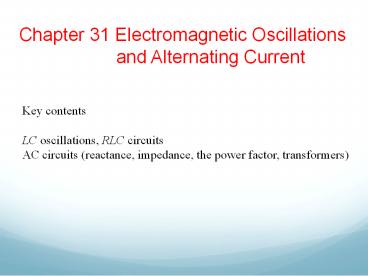Chapter 31 Electromagnetic Oscillations PowerPoint PPT Presentation
Title: Chapter 31 Electromagnetic Oscillations
1
Chapter 31 Electromagnetic Oscillations
and Alternating Current
Key contents LC oscillations, RLC circuits AC
circuits (reactance, impedance, the power factor,
transformers)
2
31.2 LC Oscillations
3
31.3 The Electrical Mechanical Analogy
The angular frequency of oscillation for an ideal
(resistanceless) LC is
4
31.4 LC Oscillations, Quantitatively
The Block-Spring Oscillator
The LC Oscillator
5
31.4 LC Oscillations, Quantitatively
The electrical energy stored in the LC circuit at
time t is, The magnetic energy is But
Therefore
6
Example, LC oscillator, potential charge, rate of
current change
7
31.5 Damped Oscillations in an RLC Circuit
8
31.5 Damped Oscillations in an RLC Circuit
Analysis
9
Example, Damped RLC Circuit
10
31.6 Alternating Current
wd is called the driving angular frequency, and
I is the amplitude of the driven current.
11
31.6 Forced Oscillations
12
31.7 Three Simple Circuits i. A Resistive Load
We are concerned with the potential drop
(voltage) along the current flow, and the phase
lag of the current w.r.t. the voltage, which is
in phase with the driving AC emf.
13
31.7 Three Simple Circuits i. A Resistive Load
14
Example, Purely resistive load potential
difference and current
15
31.7 Three Simple Circuits ii. A Capacitive
Load
XC is called the capacitive reactance of a
capacitor. The SI unit of XC is the ohm, just as
for resistance R.
16
31.7 Three Simple Circuits ii. A Capacitive
Load
17
Example, Purely capacitive load potential
difference and current
18
31.7 Three Simple Circuits iii. An Inductive
Load
The XL is called the inductive reactance of an
inductor. The SI unit of XL is the ohm.
19
31.7 Three Simple Circuits iii. An Inductive
Load
20
Example, Purely inductive load potential
difference and current
21
31.7 Three Simple Circuits
22
31.9 The Series RLC Circuit
Fig. 31-14 (a) A phasor representing the
alternating current in the driven RLC circuit at
time t. The amplitude I, the instantaneous value
i, and the phase(wdt-f) are shown. (b) Phasors
representing the voltages across the inductor,
resistor, and capacitor, oriented with respect to
the current phasor in (a). (c) A phasor
representing the alternating emf that drives the
current of (a). (d) The emf phasor is equal to
the vector sum of the three voltage phasors of
(b).Here, voltage phasors VL and VC have been
added vectorially to yield their net phasor
(VL-VC).
23
31.9 The Series RLC Circuit
24
31.9 The Series RLC Circuit, Resonance
25
31.9 The Series RLC Circuit, Resonance
26
31.10 Power in Alternating Current Circuits
The instantaneous rate at which energy is
dissipated in the resistor The average rate
at which energy is dissipated in the resistor,
is the average of this over time Since the
root mean square of the current is given
by Similarly, With Therefore,
where
The factor cos ? is called the power factor. For
a given emf and a desired power consumption, a
lower power factor means a larger current, which
will cause larger line loss.
27
(No Transcript)
28
(No Transcript)
29
31.11 Transformers
In electrical power distribution systems it is
desirable for reasons of safety and for efficient
equipment design to deal with relatively low
voltages at both the generating end (the
electrical power plant) and the receiving end
(the home or factory). On the other hand, in the
transmission of electrical energy from the
generating plant to the consumer, we want the
lowest practical current (hence the largest
practical voltage, for a given generation power)
to minimize I2R losses (often called ohmic
losses) in the transmission line. For a given
emf source, the maximum energy transfer to a
resistive load is to have the load resistance
equal to the emf source resistance. It is the
same for AC devices, but here we need impedance
matching. A transformer can effectively change
the voltage and the impedance in a circuit.
30
31.11 Transformers
Because B varies, it induces an emf in each turn
of the secondary. This emf per turn is the same
in the primary and the secondary. Across the
primary, the voltage Vp Eturn Np. Similarly,
across the secondary the voltage is Vs EturnNs.
31
31.11 Transformers
If no energy is lost along the way, conservation
of energy requires that
Here Req is the value of the load resistance as
seen by the generator. For maximum transfer
of energy from an emf device to a resistive load,
the resistance of the load must equal the
resistance of the emf device. For ac circuits,
for the same to be true, the impedance (rather
than just the resistance) of the load must equal
that of the generator.
32
Example, Transformer
33
Homework Problems 17, 26, 42, 48, 58

